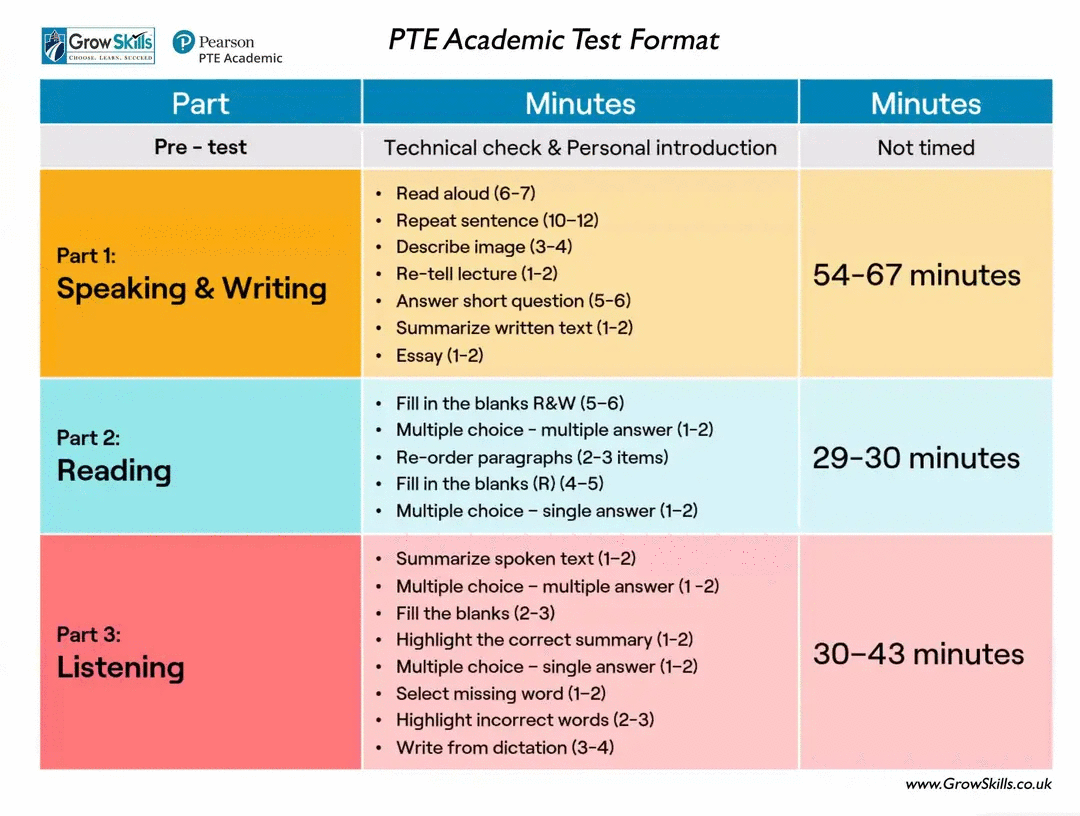No courses in the enrolment list.
If you plan to take the PTE Academic test, you might wonder how to prepare for it effectively. PTE Academic is a computer-based test that assesses your English language skills in four areas: speaking, writing, reading, and listening.
PTE is widely accepted by universities, employers, and immigration authorities worldwide. But how can you ace this test and achieve your desired score?
In this blog, PTE Magic will share some tips and strategies that will help you improve your performance and confidence in the PTE Academic test.
Whether a beginner or an advanced learner, you will find useful information and resources to guide your PTE exam preparation.
So, let’s get started!
|
How to FINALLY Pass the PTE and Achieve Your Dreams
Stop guessing! Start using proven methods that guarantee results!
✅ Master Every Section: Discover INSIDER SECRETS that secure HIGH SCORES. ✅ Save Time & Effort: Study SMARTER with proven strategies for FAST results. ✅ Real Practice, Real Confidence: Practice with TEST-LIKE questions to feel FULLY PREPARED.
START YOUR PTE SUCCESS JOURNEY TODAY
|
Key Takeaways
- PTE exam preparation is crucial to achieving your desired score and succeeding in your academic or professional goals.
- You should have the PTE exam preparation for two periods, including before and within the test.
- We have listed the 10 most important things you must note for PTE preparation. See the details below.
Related:
- Check out our PTE speaking class for even more training today!
How to prepare for PTE: Top 10 most important things

We have listed the 10 most important things you must note for PTE preparation. Remember to consider all carefully to achieve the best result. In particular:
Have Your Target Score
Unlike other exams that give you a pass or fail grade, PTE tests measure your test performance with a numerical score. The PTE score chart reflects how well you can communicate in English for different purposes. It would help if you achieved a certain minimum score depending on where you want to study, work or migrate.
Finding the minimum score required for your desired destination is important, as it will help you plan your test preparation and set realistic goals.
When you want to achieve a PTE score of 66+ (respectively 7.0 IELTS), you must make many efforts and focus more during your practice. However, this also depends on your English proficiency level and academic basis.
Related:
Practice The PTE Exam Format
If you don’t catch the right PTE examination format, you won’t know how to crack the PTE exam effectively. This can be explained because the PTE format is important in navigating timetables and knowledge for each part, including speaking, writing, reading, and listening.

The PTE Academic has three sections, distributed over 2 hours. Below are our estimations about the timeframe for four skills, such as
- Speaking & Writing (54-67 minutes)
- Reading (29-30 minutes)
- Listening (30-43 minutes)
You should visit the official PTE website https://www.pearsonpte.com/ to have an overall guide about the PTE test sample. From that, you should take note for:
- Common tasks and questions in three sections
- PTE exam preparation tips
- Official instruction videos
- How your test is scored
Related:
- What’s the meaning of Pearson in PTE?
- PTE Question Bank: Question Types, Format & More
- PTE Collocation List: Everything You Need to Know
Understand How the PTE Test Is Scored
Some questions require you to type with “correct” meanings, while others force you to adopt both “formal aspects” and “quality of the response.” You can make a lot of mistakes if you ignore this problem.
- Formal aspects are related to the shape of your response: for instance, whether your answer meets or exceeds the word counts for a specific item type.
- The quality of your response reflects your skills in domains such as speaking smoothly, pronouncing clearly, and understanding well.
When you finish your PTE test, you will receive a Score Report and a Skilled Profile to prove your English proficiency. In particular:
- Score Report: Overall score (10 – 90) and Communication Skills
- Skilled Profile: Short Writing, Open Response Writing and Speaking, and Multiple-skills comprehension.
Split up the PTE questions
One way to do that is to split up the questions based on their difficulty, impact, ease, advantage, risk, caution, improvement, and practice. Doing so allows you to allocate your time and energy wisely and maximize your score with 73-80 questions in 20 tasks. This is a key skill that can make a difference in your performance.
Get Section-wise Tips
We will list useful tips for four sections: reading, speaking, listening, and writing. In particular:
- PTE Speaking: Focus on oral frequency and pronunciation requirements. You can record your voice for all speaking tasks, then check and fix them many times to improve your speaking skills.
- PTE Listening: Try to practice this skill through films, postcards, radio, TV, or music. Moreover, skimming and scanning to get the best notes for your listening answers would be best.
- PTE Reading: Learn vocabulary and practice PTE reading as much as possible. Remember to understand English grammar deeply and try exercises regarding verbs, adjectives, nouns, and adverbs.
- PTE Writing: Understand the topic and draw a simple outline before Writing. You should check more with the PTE writing format and complete Summarise Written Text in one sentence.
Have a Detailed PTE Study & Preparation Plan
If you don’t know how to prepare for PTE correctly, let’s start with a detailed PTE study plan. You must ensure that your project can help you optimize your practice time and final result. For example:
- Difficult parts for you: Spend at least two hours/per day on these tasks and try to practice constantly. Remember to collect and note repeated mistakes and new points to improve your skills.
- Your strong areas: Learn to save time for these parts and spend at least half an hour on them.
- Tricky questions: Know common mistakes and learn to correct them effectively. You should ask your teacher or expert to understand these questions deeply.
- High-intense practicing tasks: Note useful tips and prepare good strategies for some common formats. Please read the previous year’s questions to get familiar with them and draw some forecasts.
Focus Time-Management Skills
It is challenging to answer 73-80 questions in a 3-hour exam. You must practice reading, comprehending, and writing the questions quickly and accurately.
Scanning and skimming are essential skills for this task. However, you should not neglect to review your answers before submitting them. This is a frequent error that can cost you marks.
Prepare Study Materials
Many study sources are available online, but not all are reliable or updated. The best PTE study materials are known as the official PTE website.
However, you can try other study sources, such as the E2Language platform, the PTE Academic app, and the PTE Success platform. Using these sources can improve your chances of achieving your desired score on the PTE Academic test.
Learn Vocabulary
One of the key factors that can help you ace the PTE-A Exam is having a rich and varied vocabulary. You should expand your word bank by learning different ways of expressing the same idea.
This will enable you to avoid repetition and show your command of the language. Moreover, you should practice incorporating new words into your spoken Communication.
Keep Confidence
You must speak with confidence, even in chaos. Before the exam, please use a microphone and headphones to practice your voice.
Imagine you are in a noisy exam hall, with distractions all around. You can turn on the TV, blast the news, and not let it bother you. This can make you get familiar with an actual exam environment.
Try This Effective PTE Study Plan
Below is the detailed PTE study plan template for you to follow and consider carefully. Don’t miss it to enjoy it better with PTE.
Days |
Study Plan |
Mon |
|
Tue |
|
Wed |
|
Thu |
|
Fri |
Practice the mock test and check your performance and score for 4 skills (Listening, Reading, Speaking & Writing) |
Sat |
|
Sun |
Rest and relax. You can also review some vocabulary or grammar rules if you want but don’t overdo it. |
How To Prepare For The Test Day?
You should have the PTE exam preparation for two periods, including before and within the test. In particular:
Before The PTE Test
Before you go to the PTE test center, you must prepare the necessary documents and identification that you will have to show there. Remember to check the requirements on the official website and ensure everything is ready.
You should also plan your travel and leave early to avoid delays or traffic jams. This will help you to restrict the risk of missing your test or arriving in a hurry and stress.
During The PTE Test
During the PTE Test, you should follow some tips and strategies to maximize your score and performance. This can bring different benefits for you to approach your aimed score. Let’s find out what you should do in the PTE center below.
First, you should read the instructions carefully and understand what each task requires you to do. Don’t skip or rush through the instructions, as they may contain important information or hints.
Second, you should manage your time wisely and allocate enough time for each task. You should use the screen’s timer to monitor your progress and pace yourself accordingly.
Third, you should check your work before submitting it and correct any mistakes or errors. Please don’t leave any blanks or incomplete answers, as they will lower your score. Use correct grammar, spelling, punctuation, and vocabulary in your responses.
Finally, you should stay calm and confident throughout the test and not let any difficulties or distractions affect you. Always try to solve it as best as possible or move on to the next question. Remember that you have prepared well for the test and can do it.
Conclusion
PTE Exam Preparation is crucial to achieving your desired score and succeeding in your academic or professional goals. By following the tips and strategies we have shared in this blog, you can improve your skills, confidence, and performance in the test.
You can also use our online platform to access high-quality materials, practice tests, feedback, and support from expert tutors. Whether you are a beginner or an advanced learner, we have the right course. Don’t wait any longer and start your PTE Exam Preparation today. You will be amazed by the results.
|
How to FINALLY Pass the PTE and Achieve Your Dreams
Stop guessing! Start using proven methods that guarantee results!
✅ Master Every Section: Discover INSIDER SECRETS that secure HIGH SCORES. ✅ Save Time & Effort: Study SMARTER with proven strategies for FAST results. ✅ Real Practice, Real Confidence: Practice with TEST-LIKE questions to feel FULLY PREPARED.
START YOUR PTE SUCCESS JOURNEY TODAY
|
Last updated on 10/03/2025

My name is Moni, and I am a seasoned PTE teacher with over 6 years of experience. I have helped thousands of students overcome their struggles and achieve their desired scores. My passion for teaching and dedication to my student’s success drives me to continually improve my teaching methods and provide the best possible support. Join me on this journey toward PTE success!



























I am a firm believer that the best teachers educate with their hearts not just their minds.
Moni | PTE MAGIC International Founder
Explore PTE
Tips & Tricks
If you’re planning to move to Australia, this checklist for moving to Australia as an...
Read more →Which is the best English test for Australian immigration? This blog will explain the importance...
Read more →How to find a job in Australia as an international student? This blog by PTE...
Read more →